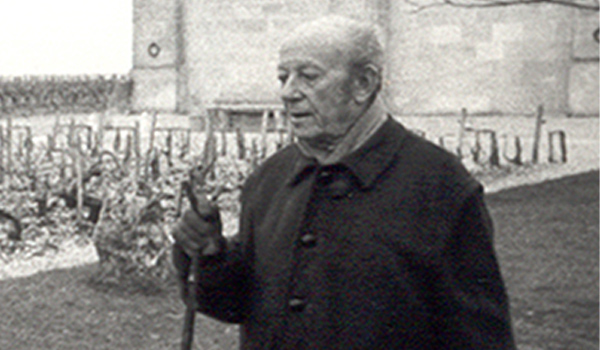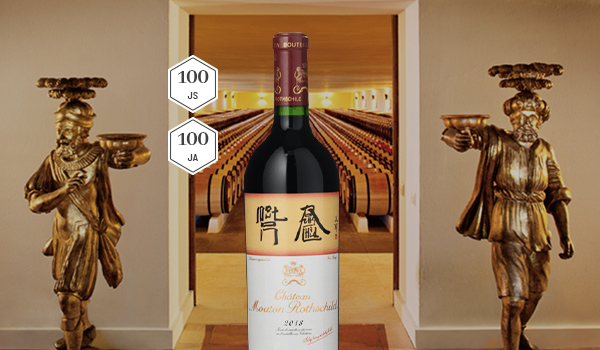The Miracle of Mouton
Ned Goodwin MW shines a spotlight on the revered Château Mouton-Rothschild.
If one seeks a tale of insidious local rivalries, lathered in headline-grabbing scandal and stained with brilliant wine, look no further than Château Mouton-Rothschild.


Mouton is situated in Pauillac, the Bordeaux commune, situated some 50 kilometres outside of the city. Pauillac is responsible for the most age-worthy of Bordeaux’s red wines. Hewn of a saline wisp and alluvial gravels squeegeed from the draining of the Medoc and the proximity to the Gironde, long barrel ageing is a prerequisite to placate the torque of Pauillac’s tannic mettle. Pauillac is also home to châteaux Latour and Lafite, each embossed with the commune’s typical graphite, black currant and cigar-box stamp to varying effects. Mouton, though, swathes those in a creamy velour and soaring florals. The world’s preeminent commentator on Bordeaux, Jane Anson posits that Mouton boasts a ‘swirl of glamour to its rich cassis fruits and cigar-box aromatics that makes it unmistakable no matter what the vintage’.
Propitiously situated on the Grand Plateau de Mouton, framed by slopes descending to the Gironde Estuary, Mouton boasts 90 hectares, today planted to Cabernet Sauvignon (81%), Merlot (15%), Cabernet Franc (3%) and Petit Verdot (1%). Approximately 40% of production is dedicated to the first wine (20-25,000 cases), 40% to the second Petit Mouton and the remainder, dispersed across the company’s wider range. Holdings include a five-hectare smattering of centurion vines, an enviable rarity in the region. According to Anson, these vines attest to the perfect harmony between vine and site. The geology of the Plateau, too, is noteworthy, appearing as a large rectangle of gravel with a dollop of humus-rich clay to the ratio of 98:2. The astounding dominance of free-draining gravel suits the late ripening Cabernet Sauvignon to a tee. Less so, Cabernet Franc. Director Phillippe Dhalluin opines that Franc ripens in one of every three years, imbuing lift and salinity when it does so with a whisper of its future potentiality as the climate warms.
The confluence of the brilliant site and the Grand Vin’s track record suggest that Mouton’s righteous inclusion among the upper echelon was a given such is the rigidity of the establishment and perceivable immutability of those at the top. Mouton’s wines, too, have always been traded at similar pricing to those of its feted neighbours. Moreover, Château Mouton had been acquired by Nicolas-Alexandre de Ségur in 1718. De Ségur already owned châteaux Lafite and Latour. Yet despite these lofty connections, Mouton was excluded from the top tier of the 1855 Classification for reasons that are surely spurious and apocryphal, as others are truthful. What is true is that the property’s ownership differed radically from the four original First Growths during the 16th and 17th centuries. Mouton also lacked a grand château, while the Rothschilds’ Anglo-Semitic heritage purportedly sat poorly with the local establishment.
The Classification of course has become an anachronism. It was based on the putative connection between pricing and quality, established to promote French wine at the Paris World Fair (Exposition Universelle de Paris) of the same year, by the Minister of Agriculture Chaptal upon request by Emperor Napoleon III. In other words, the higher a wine’s pricing in the market, the higher the wine's ranking in the Classification. A simple system of five tiers, founded on the sequential success of the wines, it was ingenious. It was hierarchical and easy to understand. Yet times change. Many, myself included, think the classification should be reviewed and updated regularly to take into account the ebbs of investor and ownership changes to Bordeaux’s great wine estates and flows of quality, up and down, that result. Yet while a full review and overhaul are unlikely due to repercussions on pricing, their impact on livelihoods and the political ramifications among the powerful and elite, Mouton audaciously challenged the intransigence of the Bordeaux hegemony. Mouton proved that miracles can happen and that change in these parts lies within a purview of political influence, dogged persistence and deep pockets.
Shop the Château Mouton Rothschild portfolio.
Shop the Château Mouton Rothschild portfolio.
Today, with a whiff of considerable irony, Mouton is but one of two classified châteaux (with Léoville Barton) in the Médoc to have remained in the hands of the same family since 1855, that egregious year in its history, or ‘monstrous injustice’ as it is called by the inner Rothschild circle. As meritorious, Mouton was instrumental in two moments that served to shape-shift the dynamics of the Médoc long before the involvement of the Rothschilds. The first, under the ownership of Nogaret de Valette in the early 17th Century, was the hiring of Dutch engineers to drain the Médoc swampland and render it suitable for agriculture including wine grapes. The subsequent waterways also served to facilitate the transport of wine from the region, inadvertently opening Bordeaux and its wares to the world. The second, under the ownership of Baron Hector de Brane, known as the ‘Napoleon of the Vines’, was the introduction of Cabernet Sauvignon to the region in 1720 or thereabout, when wine grapes first appeared in the region.
De Brane then sold Mouton to a banker, Isaac Thuret in 1830. While the pricing of the wine remained on par with its top rivals, it is said the quality had begun to lag due to the peripatetic nature of Thuret’s profession and his regular absence from the estate. Thuret sold Mouton to Nathaniel de Rothschild in 1853 who immediately employed a vineyard manager in the attempt to return the wine to its former pedestal. It is suggested that Rothschild’s last dash efforts were too late and that Mouton’s Second Growth classification was the result. Yet this is surely little more than further rumour mongering given that the Classification was a mercantile ranking system designed for PR purposes, rather than an intrinsically qualitative one. After all, the Bordeaux Chamber of Commerce that devised the Classification contained no wine experts.
Despite the disappointment of Mouton’s ranking, Rothschild continued to invest heavily in the vineyard in the pursuit of quality. Nathaniel died in 1870 and his son, Baron James, took over. He passed away soon after the bequeathment, and the property was passed to his eldest son, Henri. Henri showed little interest and from that point Henri’s second son Baron Philippe took control and assiduously began to pave the ‘Yellow Brick Road’ that led to Mouton’s status today. Philippe took over in 1922 at the age of 20, after being equated to the family digs during World War 1. He liked what he saw and bought out his brother and sister in 1947 to assume full ownership.
Under the Baron, Mouton became the first estate to bottle its entire production en situ from 1924, extricating the power from the négociants and placing it firmly in the control of the estates. The Baron and later, his daughter Baroness Philippine and now, his three grandchildren, set the tone for the way the entire Bordeaux region perceives itself and continues to do business today.
‘...Baron Philippe’s swashbuckling convictions gained weight due to his diligence and forthrightness, as much as his connections with fame and wealth. Yet he is best remembered for the test of endurance that he passed with stoic discipline: elevating Mouton to its rightful position among the crème de la crème...’
The Baron then set about cultivating a regal aura, a prerequisite to perceived grandeur. He built the much needed Grand Chai to store the wine, commissioning a well known architect in 1926. This was not only a grand front, but a pragmatic means to ensure full quality control and the integrity of the Mouton name. In addition, a new label was designed by artist Jean Carlu and signed by Philippe in all vintages but for 1938-1940, when Philippe was imprisoned by the Vichy regime. He escaped and fled to England. His wife was not so fortunate, dying in a concentration camp in 1945.

Baron Philippe de Rothschild (1902-1988)
During the war, Mouton was occupied by the Germans who controlled production. Hermann Göering appointed himself cellar master. Baron Philippe returned after the war and returned the estate to a dynamic defined by an inexorable rise of stature. A new label was designed in commemoration by Philippe Julian, resplendent with a V for Victory insignia serving as a catalyst for the tradition of commissioning a new label every year, designed by a different artist. These have included George Braque (1955), Salvador Dali (1958), Wassily Kandinsky (1971), Pablo Picasso (1973) and Andy Warhol (1975), to name but a few. The sole exception was the 2000 vintage, which was commemorated with a gold enamel bottle. On two occasions there were two labels by the same artist. The first, in 1978, when Baron Philippe liked the two designs submitted by Jean-Paul Riopelle so much that he split them across the production. The other was the label designed by Balthus for the 1993 vintage. A nude portrait was deemed inappropriate by US authorities and was replaced by a blank white space. Ironically, the latter became the more collectible of an ‘off vintage’.
Baron Philippe’s swashbuckling convictions gained weight due to his diligence and forthrightness, as much as his connections with fame and wealth. Yet he is best remembered for the test of endurance that he passed with stoic discipline: elevating Mouton to its rightful position among the crème de la crème and inciting the first major change to the Classification since its inception (Château Cantemerle was added in a minor adjustment in 1856). For 50 years Philippe had been driven by the mantra printed on his labels: Premier ne puis, second ne daigne, Mouton suis, which translates: First I cannot be, second I do not deign to be, I am Mouton. Philippe changed it accordingly when finally, Mouton was elevated to the Premier Grand Cru Classé firmament in 1973 following years of exhausting lobbying and lawsuits. It now reads Premier je suis, second je fus. Mouton ne change, meaning First I am, second I was. Mouton does not change.
It was only fitting that soon after, in 1976, Mouton 1970 was the top-rated French wine at the Judgement of Paris, a seminal face-off between top Napa Valley red wines and classed Bordeaux. With symbolic gravitas, James Bond sees through the disguise of a villain, an erstwhile sophisticate, when he fails to recognise Mouton, just as Mouton’s evergreen quality was passed over all those years ago.
Philippe died in 1988 and today the estate is run with gusto by his daughter, Baroness Philippine de Rothschild. The new generation is headed by her son Baron Philippe Sereys who, incidentally, does not like to be called by his noble title. He has continued to expand the firm’s domestic and International holdings. These include second label le Petit Mouton (with label designed by Jean Carlu, who designed the very first label for the Grand Vin) châteaux Clerc-Milon and d’Armailhac, as well a co-ownership of Chile’s Almaviva and Napa’s Opus One. One wonders, perhaps, why is there no investment in Australia.
Philippe undertook a complete renovation of the cellar in 2013, installing gravity-fed vats in a 70 metre long room. 20 are stainless steel and 44 made of oak, each differently sized to reflect the volume from the vineyard plot/s for which they were designed. From 1991, there has also been a white wine. A typical blend of Sauvignon Blanc and Semillon, Mouton is one of a handful of properties that induces a degree of malolactic conversion (circa 10%) to emphasise texture over varietal fruit characteristics.

The revered Château Mouton-Rothschild
Yet upon reflection, the innovative air of Mouton is as reflective of a swaggering past, aspirational hauteur and sense of belief in its rightful provenance, ensconced not only on the gravels of Pauillac, but as a rightful member of the First Growth firmament. The style of Mouton remains one of perfume, salubrious texture and pizazz. Come to think of it, Baron Philippe would not have had it any other way.